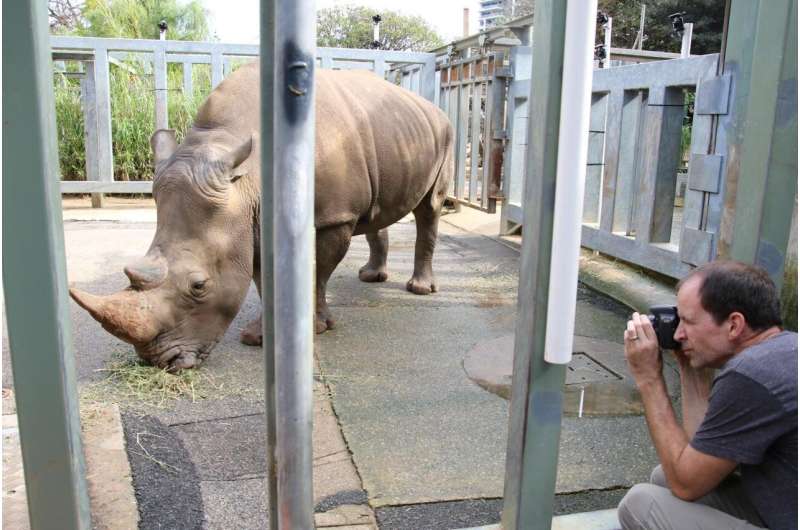UMass Amherst and Perth Zoo released the world's first accurate, publicly available 3D model of the rare Southern white rhino. For some conservationists and researchers, this kind of model is the first step they can now take to reconstruct body composition and condition in the field to assess how healthy an animal is. Credit: UMass Amherst/Perth Zoo
The Digital Life team at the University of Massachusetts Amherst led by evolutionary biologist Duncan Irschick and other colleagues released the world's first accurate, publicly available three-dimensional (3-D) model of the rare Southern white rhino in collaboration with Perth Zoo in Australia.
As Irschick explains, this particular rhino is not yet extinct, but rhinos in general are under extreme pressure around the world, are vulnerable to climate change and are often the targets of poaching. The Digital Life team traveled to the Perth Zoo to digitize the southern white rhino there, named Bakari, using a ring of cameras that photo-captured him in 3-D for release on September 22, World Rhino Day.
In appreciation of their collaboration, Irschick says, "The Perth Zoo shares our vision about how public outreach and the scientific data gained from this model can benefit society." The zoo plans to release a video of the rhino with Irschick talking about making the 3-D model.
For some conservationists and researchers, this kind of model is the first step in a series they can now take to reconstruct body composition and an animal's body condition in the field to begin to assess how healthy an animal is, Irschick says. "You can't just walk up to a rhino in the field, but using a variation of these methods in the field, one could recreate the body shapes of such animals. We believe it is a powerful tool with many applications beneficial to wildlife."
This project follows other work by Irschick and colleagues, who have created several different "Beastcam," rigs that include hand-held and tripod-mounted instruments in a variety of sizes. The original Beastcam Array consists of 10 fixed arms, each of which can mount three cameras for a 30-camera array. Small animals placed in the center can be quickly and conveniently modeled in 3-D by the cameras plus software.
"We have even used variations of this method for photo-capture of live sharks underwater," Irschick notes. For the Perth Zoo rhino project, they were able to photo-capture Bakari from a distance, allowing the animal to be comfortable and follow its normal daily routine.
Irschick's Digital Life research group is the only one in the world that creates high-quality models of living animals and makes their models and data publicly available, he notes. "The Digital Life lab is a sort of archive for animals, many of which are highly endangered, or soon could be. The project lives as an interactive 3-D digital database used by museums, educators, artists and scientists" he notes. "We've done a fair number of frogs, lizards and sea turtles; this rhino represents our first foray into megafauna."
For the Southern white rhino project, technicians and zoologists at Perth Zoo used 20 cameras to take photos from all 360 degrees in a safe, non-invasive way. The Digital Life Project then brought on CGI artist Jer Bot to recreate the rhino and animate it, Irschick explains. "The complex data reconstruction is like putting Humpty Dumpty back together again, but Jer did an amazing job," he notes.
Bot used the open-source software Blender, including many of its new tools, to recreate the rhino, Irschick points out. Once finished, the Digital Life team placed the 3-D rhino on the Sketchfab website for free non-profit dissemination.
Perth Zoo's interpretation officer, Alan Gill, says, "It is exciting for Perth Zoo to participate in creating 3-D models that can be used for wildlife conservation and education. Our animals are ambassadors for their species, and we're thrilled that Bakari can continue to advocate for Southern White Rhinoceros conservation programs right around the world."
The Digital Life Project and its unique capabilities are in high demand, Irschick says. "Our models have been downloaded over 20,000 times, and we receive inquiries for partnerships with various scientific and creative teams regularly. This leads me to believe that high-quality, high-detail, high-resolution models with natural texture are highly desirable. We certainly see a lot of excitement and interest over this."
The Digital Life project will continue to use the Beastcam technology and other methods to provide 3-D models at no cost for creative or nonprofit use on their website. Irschick and his team hope that making the models of living animals will promote conservation, science and research, and public awareness, not only for endangered species but for more common ones that are crucial to ecosystems around the world.
More information: digitallife3d.org/
Provided by University of Massachusetts Amherst
























